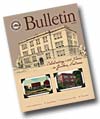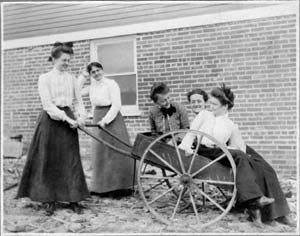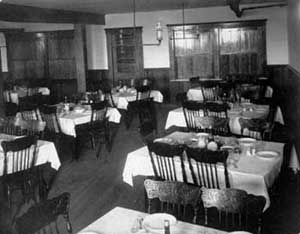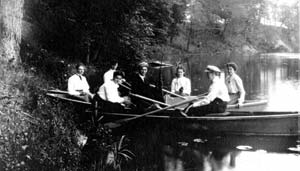One remarkable year:
1903-1904
By Susan Fisher Miller
'79
Goshen College was transformed from vision to reality in the course
of one remarkable year. In June 1903, the spot in Indiana that would
become Goshen College glimmered only in the imagination of a crowd
gathered in a south Goshen wheat field. By the following June, 1904,
Goshen College faculty and students welcomed guests into their Administration
Building’s freshly paneled Assembly Hall to celebrate the
college’s first group of graduates.
Vision and expansion
Since its founding in 1894, Goshen College’s parent school,
the Elkhart Institute, had grown rapidly. Consisting at first merely
of its founder H. A. Mumaw, four students and a rented classroom,
by 1896 the Elkhart Institute boasted enough scholars, faculty and
supporters to have erected its own building on Elkhart’s Prairie
Street, opposite Prairie Street Mennonite Church. A Mennonite and
Amish Mennonite constituency provided an increasing amount of the
school’s financial support, students and staff.
In 1898 the Elkhart Institute hired principal Noah E. Byers, a new
graduate of Northwestern University with a large vision for Mennonite
intellectual life and an ambition to raise Elkhart Institute’s
academic standards. Byers recognized the need for expansion. Institute
Hall could not accommodate the large audiences that attended literary
programs and commencement exercises. There were no dormitory facilities;
students from Ohio, Illinois or Canada roomed in Elkhart city homes
or hotels (though “Lady and gentlemen students shall not take
rooms in the same home.”). The Institute operated a dining
hall at 424 South Main Street, but its clientele included outside
patrons as well as students. Students had to apply to the Elkhart
YMCA for the use of its reading room, gymnasium and bathtubs. The
Prairie Street Mennonite meeting house served as de facto campus
extension, but attempts to determine the academic and congregational
parameters had strained the relationship at times. For all the loyal
student spirit evident in the Elkhart Institute years, campus life
was more diffused than ideal.
To complicate matters, the handsome brick Elkhart Institute building,
still new upon Byers’ arrival in 1898 and the school’s
proud symbol, stood on a small lot without available adjacent land;
its property could not be enlarged. Worse, it flooded: the structure
had been planted atop an underground watercourse, which, as college
historian John S. Umble observed, “flooded the basement during
spring freshets sometimes putting out the fire in the furnace.”
The Institute required a new property with room to grow. In 1901,
the board of directors of the Elkhart Institute Association appointed
a committee to entertain proposals from localities interested in
attracting the school. Naturally, the City of Elkhart desired the
thriving Institute to stay in the city, and a wooded acreage in
the city’s Highland Park area (now named McNaughton Park,
located southwest of Elkhart General Hospital today), 10 minutes
by streetcar from Main Street, was soon identified as the leading
site. But the location committee also received proposals from the
smaller nearby town of Goshen and from the Ohio communities of Wadsworth,
where a former Mennonite school’s buildings had become available,
and West Liberty, where other school buildings were up for sale.
Sites in Illinois and Pennsylvania also came in for consideration.
The Elkhart Chamber of Commerce made a concrete proposal for a joint
effort in which the Institute and its supporting church would raise
money for buildings, and the city of Elkhart would furnish land
and additional financial support. So likely it was that the school
would remain in Elkhart that the Institute’s commencement
week program for 1902 featured a cross-town foray to “the
possible future home of the Institute at Highland Park.”
Meanwhile, enterprising members of the Goshen citizenry had also
been promoting various locations. Just before leaving the Institute
in the fall of 1902 for a year of advanced study at Harvard University,
Principal Byers, with business manager C. K. Hostetler, toured some
of the Goshen sites. These included an east-side site on East Lincoln
Avenue, a north Goshen hilltop location and two south-side locations:
one of them, Burns Park, was a full mile from the city, and the
other lay within the Shoup farm that stood in an area of Goshen
known as the Parkside.
Most appealing, initially, of the Goshen sites was a west Goshen
property near what is now the Old Bag Factory (it then housed the
Cosmo Buttermilk Soap Company, which was purchased in 1910 to initiate
a “bagology” industry). This property lay west of the
Elkhart River and had the advantage of including a ready-made college
gymnasium in the guise of a barn. But the river, however scenic,
inhibited easy access to downtown, and struck the committee on location
as too isolating from the center of Goshen. Thus Elkhart’s
Highland Park continued at the top of the list. The Elkhart Institute
Association even began the provisional sale of building lots in
the Highland Park locale.
But an unexpected sequence of events turned things in Goshen’s
favor. Something about the Parkside location had drawn Hostetler
and J. S. Shoemaker of the Institute’s committee to return
for a second, approving look at the Shoup farmland in January 1903.
Then, in the spring of that year, Elkhart entered a period of financial
crisis, in which some businesses failed and a bank closed. The uncertain
economic outlook led the Highland Park Association to raise the
original price for access to their property, an unwelcome surprise
to the Elkhart Institute negotiators.
At the same time, two Goshen community leaders – businessman
Wilbur L. Stonex and an attorney, Anthony Deahl, president of the
Goshen Commercial Exchange – launched an energetic fundraising
campaign among Goshen citizens to bring the Institute eastward.
In businessman Stonex’s shrewd rhetoric, the coming of a college
to Goshen would outdo a factory’s commercial benefits any
day – and a college brought cultural riches to boot. By May
15, Stonex and Deahl had the pledges they needed.
On May 27, 1903, Institute representatives Jonas S. Hartzler and
C. K. Hostetler signed a contract with the Commercial Exchange of
Goshen. The city had subscribed pledges in the amount of $10,000
to secure the college site; the Institute Association would immediately
erect a main college building at the cost of $25,000 and purchase
south Goshen land to be sold for housing lots. In a final stipulation,
for at least 10 years the institution would be called Goshen College.
On June 12, 1903, the Institute’s commencement week program
included an excursion to Goshen. Riding specially chartered interurban
cars, 150 students, faculty and friends of the Elkhart Institute
traveled to the site of the newly designated Goshen College, where
they were met in the Shoup farm fields by an equal number of Goshen
well-wishers. Speeches ensued, and a 20-member male chorus of Institute
students, directed by music instructor Wellington K. Jacobs, performed
to acclaim. After these ceremonies, Hartzler, who had faithfully
served Elkhart Institute as minister, business manager, instructor
and board member, guided a plow behind a large team of bay horses
to break ground for a new campus amidst the soon-to-be harvested
wheat.
A triumph of culture, service and elbow grease
The year that followed might be called a triumph of culture, service
and elbow grease. The ability to improvise – an adaptive gift
that would stand the college in good stead for the next century
– frequently came into play. Yet from the start, there was
also at work in campus life a steady drive of confident purpose.
Excavation for a dormitory had begun immediately, “while the
shocks still dotted the field,” in John Umble’s phrase.
The Aurora literary society had donated the cornerstone for the
Administration Building. Construction continued all summer, but,
in the classic pattern of construction, was in no way complete when
the first students, 77 of them, arrived on Sept. 28, 1904. Boards
were shuffled about as impromptu walkways through the mud wallow
surrounding the buildings. Even the immaculately groomed, erudite
President Noah Byers, just returning from his sabbatical at Harvard,
pitched in among the faculty to haul debris during the first week.
A dormitory, East Hall, was in place just in time for the beginning
of the term. But since the bricks of the campus centerpiece, the
three-story Administration Building, had risen only to first floor
level, the verandah-bedecked East Hall became the center of college
academic, social and devotional life, as well as fulfilling its
intended purpose of housing and feeding students. (The venerable
East Hall, standing to the east and at right angles to the Administration
Building, was renamed North Hall upon its 1916 relocation north
of College Avenue, where it stood until its demise by fire in 1969).
Students too may have rolled up their sleeves on Saturdays to aid
in the ongoing construction, but the campus maintained a more elevated
tone the rest of the week. Social refinement did transfer from urban
Elkhart into smaller-town Goshen: it is evident in the linen-draped
tables for six and china soup bowls depicted in a dining hall photograph;
in a student’s monogrammed sterling napkin ring; or in the
decorous care given to selecting school colors (purple and white,
inherited from Northwestern by way of President Byers), class flower
(white rose, in 1904), or literary society motto (“Esse Quam
Videre” for the Avons, or “To be, rather than to seem”).
Dignity and pride of place was also in evidence in a fine the administration
levied in the first year: $5 for every scratch on the new furniture.
The advent of 58 new students in the winter term of January 1904
coincided fortuitously with the enclosure of a usable, if not completely
finished, Administration Building (“recitations” in
the new classrooms competed with the carpenters’ ongoing clamor).
A large audience thronged into Assembly Hall for its formal dedication
on Jan. 8, 1904. Soon the president’s office, a reading room,
a science laboratory and a basement gymnasium (with showers) were
up and running in the Ad Building.
Continuing traditions, expanding horizons
Despite some rough and tumble in campus facilities the first year,
Goshen College enjoyed a continuity of tradition carried forward
from the nine-year-old Elkhart Institute. Academic and cultural
endeavors at Elkhart had taken on increasingly sophisticated forms,
and this momentum continued at Goshen. For one thing, the 12 faculty
members brought an impressive array of university experiences to
their work, and, from those encounters, a passion for expanding
students’ horizons (which is not to say that students were
never caught snoozing in psychology class, a phenomenon noted as
frequent in the 1904 Reflector, Goshen’s first yearbook).
Something of this questing ethos is reflected in the opening lines
of the essay titled “In Chains,” written by Albert Benjamin
Rutt, member of the Class of 1904: “With the birth of every
soul there begins a struggle for freedom; a reaching out towards
heights of perfection; a casting aside of weights; and a breaking
of chains.”
Students and their faculty mentors channeled the restless urge to
self-improvement and intellectual elevation into the regular public
programs of four amiable, if seriously competitive, literary societies.
Elocution, oratory, debate and theatrics filled these soirées.
Music, fostered from the beginning at Elkhart, continued at Goshen
in the performances of a Ladies’ Choral Society and the Sunshine
Male Chorus, among other groups. True to Wilbur Stonex’s prediction,
the town benefited from campus’s cultural offerings, and in
its turn supplied venues and collaborators for various shared projects
such as a performance of Handel’s “Messiah” held
in the First Methodist Episcopal Church.
Campus religious life both extended the patterns familiar from Elkhart,
and pioneered new ground. The Young People’s Christian Association,
an organization nurtured at Elkhart Institute by Principal Byers,
surged after transplantation to Goshen – “the strongest,
most powerful and permanently most useful organization” on
campus, according to historian Umble writing in 1955. Soon Goshen
sent delegates from its YMCA and YWCA to annual national conferences
at Lake Geneva and Lakeside, Ohio.
When it came to forming a campus-related Mennonite congregation,
something new emerged. The school was no longer within reach of
Elkhart’s Prairie Street congregation. The Mennonite church
closest to Goshen at the time was the Clinton Frame congregation,
six miles to the east. For a month or two, seemingly with cross-denominational
ease, the campus community joined services with the Christian Church
congregation in their little white building on South Main Street,
with minister J. S. Hartzler supplying the pulpit for both groups.
By November 1903, a unique, campus-based congregation came into
being which reflected the two main strands of the institution’s
constituency, Mennonite and Amish Mennonite. The Indiana-Michigan
Mennonite Conference and local Amish-Mennonite bishops collaborated
to authorize a joint, or “union,” Goshen College Mennonite
Church that would accommodate both traditions. In short order, the
congregation held Sunday school, worship and communion services
and commissioned two mission workers to India. In January and February
1904, as part of a Winter Bible term, preacher Sanford G. Shetler
conducted meetings that led 15 at the college to confess Christ;
the Mennonite students received baptism by sprinkling, while the
Amish Mennonite candidates simply waited until April, when the temperature
of a northern Indiana stream would allow their bishop to perform
the ceremony following their tradition.
Finally, a spirit of inventive good humor animated the first year.
After a dormitory and administration building were underway, students’
next priority was tennis courts – laid out and put to coeducational
use in timely fashion (and, in tennis fashions) just north of East
Hall. Baseball and track teams were also organized. Students soon
gallantly formed a volunteer fire brigade. Chronicles of the year
also mention boating, ice skating and sleigh-riding (one apparently
nostalgic outing as far as Elkhart). Early photographs reveal swimming
parties in the Elkhart River above the dam; a bluff there was soon
dubbed College Point.
Many activities brought together faculty and undergraduates; the
numbers were intimate enough, and the faculty young enough, for
plenty of informal interaction and good-natured ribbing.
Women students were housed in East Hall, with men off campus, but
the latter were admitted into the dormitory for visiting hours from
8 to 10 p.m. on Sunday nights. A published student “Calendar”
alludes to furtive after-curfew escapes and returns and depicts
a night watchman, lantern at his side, keeping slumbering vigil
on the East Hall stairs. Students and some faculty took meals together
in the East Hall dining room, where a faculty table could be uproariously
noisy, and at least one hungry fellow lamented the infrequent appearance
of pie on the menu. Such shortages were ameliorated by taffy-pulls,
“feeds” enjoyed courtesy of home-sent care packages
and, for the seniors, the treat of an end-of-year meal in the home
of President Noah and Mrs. Emma LeFevre Byers.
With sweetness and light
On the occasion of commencement in June 1904, class salutatorian
H. Frank Reist, a member of the Aurora Literary Society and a future
Goshen College president, welcomed the audience gathered in the
Administration Building. Standing on the Assembly Hall platform,
he acknowledged the strides made since the previous June: “A
comparatively short time ago we were anxiously looking forward to
the erection of this building.” His speech went on to sound
notes consistent with the phrase “Culture for Service,”
words used by President Byers in his October inaugural address and
adopted in April as the Goshen College motto. “We have looked
forward to this event with pleasant anticipation,” Reist declaimed,
“not with the thought of having successfully finished a prescribed
course of study, but as an event which indicates our entrance into
a broader and more useful avenue of life. … New fields of
labor and need constantly appear upon our horizon.”
Fellow 1904 graduate Fannie Coffman, in composing the “class
prophecy,” envisioned a future 20 years hence in which she
toured the world to find her classmates laboring among the factory
girls of New York City, leading a mission in West Africa, working
in Brazil as a combination coffee planter-philanthropist, preaching
in Oregon and ranching in Missouri – the student in this latter
prediction having renounced his earlier notion of becoming President
of the United States. Upon return from this trip, Fannie Coffman
imagined, “I recalled our motto, ‘Culture for Service.’
Were we not all living it? Yes, each in his own way was performing
a noble service for mankind. The culture received at Goshen College
was bringing sweetness and light to many a weary burdened heart.”
Outside the Administration Building, water bubbled over the basins
of a new fountain, the gift of the Coming Men of America literary
society (soon to be known as the Adelphians). Earlier in the week,
C.M.A. secretary J. E. Hartzler had formally presented to President
Byers the fountain and surrounding sidewalks – no more planks
or wheat shocks strewn about this campus. Walking out of Assembly
Hall, with culture and service, sweetness and light still in their
ears, the people were met with the sight of a graceful fountain:
a vision of Goshen College taking beautiful, and perpetual, shape
before their eyes.
|
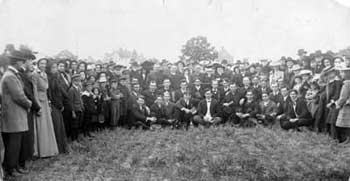 |
Groundbreaking, June
12, 1903
The Goshen News-Times reported that the 2 p.m. groundbreaking
ceremony for Goshen College attracted 250 or 300 people to a
small area cut in a wheat field. Goshen attorney Anthony Deahl,
president of the Goshen Commercial Exchange, delivered an “able
address, setting forth the interest Goshen has in location of
the school here and the interest felt in the aims and objects
of this Mennonite school of higher education, both educational
and spiritual.” Future business manager J.S. Hartzler
suggested that all sing “Blest Be The Tie That Binds.”
The News-Times concluded: “Certainly this was
an auspicious day for Goshen and Goshen College.” |
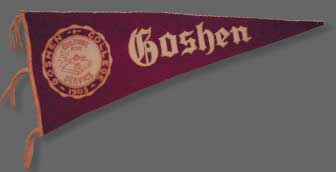 |
GC
pennant, ca. 1916
Formerly owned by J.C. Meyer ’16 |
|
|
College
cart, ca. 1904
The “college cart,” an example of an artifact tied
to campus traditions of an era nearly forgotten, served purposes
of utility and entertainment, but primarily hauled student trunks
to and from the rail depot when they arrived in Goshen. Poems
and orations published in the Record at the time of the retirement
of the second cart of three (1919) suggest a wide variety of
other, mostly mischievous, uses; on at least one occasion a
late night foray north on Eighth Street aroused faculty members
from their sleep. |
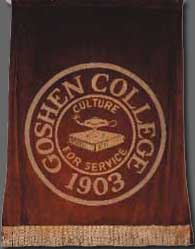 |
Culture
for Service seal
From original Union Building stage curtain, 1949
In April 1904 the college adopted “Culture for Service”
as its official motto. The phrase was the title of an early
speech by President Noah E. Byers. A scrapbook kept in the 1930s
by Ina K. Slate suggests she may have been the designer of the
college seal. Slate taught art education at GC from 1916 to
1923; her husband, George, was president of Western Rubber Co.
in Goshen. In 1933, at the age of 60, she enrolled as a GC student,
graduating in 1936. |
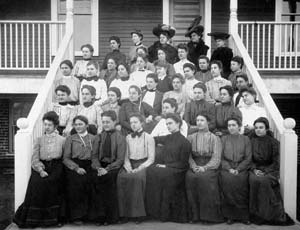 |
Ladies
on East Hall steps, 1904
The 1904 residents of East Hall, from about 10 different states,
each paid 75 cents per week for a double room (including heat,
light and 12 pieces of laundry); meals were $1.85 per week or
$22 for term. Men roomed in private houses near campus until
Kulp Hall was built in 1906. |
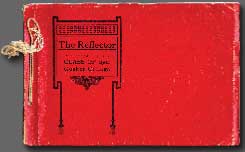 |
Reflector,
1904
The original Goshen College yearbook, before it became the Maple
Leaf.
What were they thinking?
Quotes from the 1903-04 issues of the Goshen College Record
(formerly known as the Institute Monthly)
“Just as we go to press the news comes from Goshen that
$10,000.00 has been raised to locate the Institute at Goshen.”
(Institute Monthly – May 15, 1903)
“A temporary stage had been erected in the center of the
site of the proposed first new building at the south end of
the campus. Stakes were driven to show the outlines of the structure
and the wheat was cut away from this space.”
(Goshen College Record – June and July, 1903)
“We expect to do all we can for those who must make their
own way through school. Some of the best students belong to
that class and the College can not get along without them. But
the ‘if-you-get-me-a-nice-easy-place-I’ll-come’
class had better stay at home. Only hard work and real merit
will win at Goshen College.”
(Goshen College Record – August 15, 1903)
|
 |
The
book and the lamp
In 1910, GC graduates began signing their names in this record
book. The book and the lamp illustrate the college seal. |
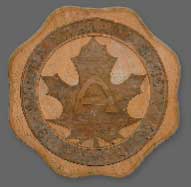 |
Literary
societies
In Elkhart, this institution’s student body had divided
itself into four literary societies. The societies had particular
interest in fostering the literary and oratorical interests
of their members. Strong group identity meant that many other
informal campus activities ranging from athletic to musical,
perhaps even romantic, divided along literary lines. The four
societies disappeared from campus life about 1962. There were
two pairs of societies for men and women. The female Avons
(with the motto “Esse Quam Videri”)
were paired with the male Auroras (with the motto “Forward”). The
female Vesperians (with the motto “Excelsior”)
were paired with the male Adelphians (with the motto “We
learn to do by doing”). |
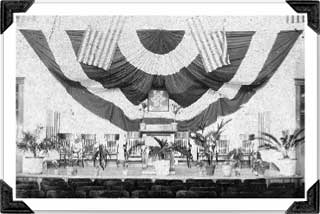 |
Commencement
reception, 1904
In April 1905, citizens of Goshen hosted GC students and faculty
at a reception in the newly completed Administration Building’s
Assembly Hall so townspeople could visit and learn more about
the college, express their gratitude and “extend the hand
of fellowship.” Extra street cars were added to help transport
people to the south end of Goshen that evening. The room was
decorated in red, white and blue, flags and carnations; the
Rogers’ orchestra played many popular selections. |
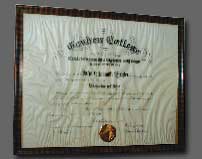 |
Bachelor
of Arts diploma, 1910
GC did not offer a four-year degree until 1910. John E. Hartzler
(1879-1963), a member of the Class of 1904, had returned to
complete his bachelor’s degree and was the first to be
handed his diploma that year. After graduation he began serving
as dean of GC’s Bible school and, from 1913 to 1918, was
GC’s president.
In 1915, M.C. Lehman received the only master’s degree
to be awarded by Goshen College to date. |
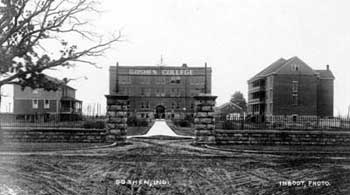
FROM
THE COLLECTION:
A century ago, the City of Goshen’s Commercial Exchange campaigned
successfully to entice the Elkhart Institute to move its campus to
Goshen. The exhibit “100 Years of Goshen College in Goshen”
pays tribute to all that has come since the first day classes began,
on Sept. 29, 1903. Hosted in the Goshen College Library Gallery, the
exhibit will continue through Oct. 5.
The Mennonite-Amish Museum Committee and the Mennonite Historical
Library sponsor the exhibit. The Library Gallery is located on the
lower level of the Harold and Wilma Good Library. Call the Mennonite
Historical Library at (574) 535-7418 to verify library hours.
Thanks to Mennonite Historical Library and exhibit curator Joe Springer
for his historical assistance on this issue of the Bulletin.
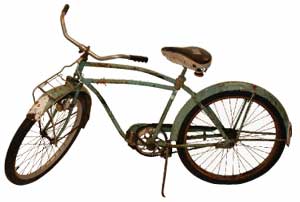 |
S.W.
Witmer’s bicycle
S.W. Witmer (1888-1990) taught biology from 1910 to 1959. After
he turned 70, Witmer began biking, rather than walking, from
his South Eighth Street home to campus. He maintained this ritual,
rain or shine, until sometime in his 90s.
|
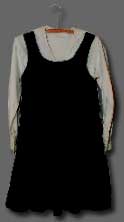 |
Women’s
gymsuit, ca. 1936
Formerly owned by
Wilma Miller Smith ’39
Wilma Miller (later Smith), captain of one of two sophomore
women’s basketball teams in 1936-37, when her team won
second place in the intramural tournament, winning four of seven
games.
|
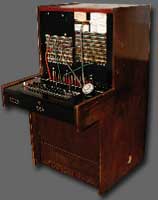 |
Westlawn
switchboard, late 1960s
Although GC probably had a telephone on campus almost from the
beginning, individual offices did not typically have telephones
until the 1950s. A switchboard went into Westlawn lobby in 1956
and, about a decade later, this larger switchboard replaced
the first one. By 1987, when telephones were installed in each
dorm room, this model was already unused and obsolete. A former
student switchboard operator, William (Bill) Archibald ’81,
took pity on it, and saved it from the junk heap.
|
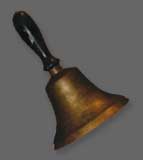 |
Kulp
Hall dinner bell
Formerly owned by Mary Royer ’30
Before construction of Westlawn in the early ’50s, students
dined “family style” in the basement of Kulp Hall.
This dinner bell was rung before the meal prayer.
|
|



